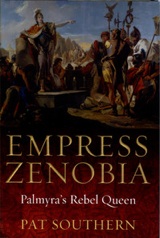Empress Zenobia: Palmyra’s Rebel Queen – Book Review
 Empress Zenobia: Palmyra’s Rebel Queen, by Pat Southern. 224 pp. Continuum, 2009, $29.95
Empress Zenobia: Palmyra’s Rebel Queen, by Pat Southern. 224 pp. Continuum, 2009, $29.95
Zenobia must have known that no Roman emperor could have tolerated foreign control of Egypt, Rome’s all-important supplier of grain
The legend speaks of a beautiful dark-eyed queen from a remote desert city who led an army into battle in a doomed attempt to defy the might of the Roman Empire. The story of Zenobia, Queen of Palmyra (in present-day Syria) has inspired a multitude of artists and dramatists. Yet, going from legend to reality is always disconcerting, and especially so in Zenobia’s case.
{default}Pat Southern’s book Empress Zenobia: Palmyra’s Rebel Queen is a comprehensive yet readable attempt to pick through the meager evidence. Her task is daunting: the surviving ancient sources were written long after the fact. They reflect a Roman bias against the queen and frequently contradict each other. Inscriptions and coins can provide additional information, but not enough to compensate for the shortcomings of the literary sources.
Zenobia was born in AD 240 or 241 in the desert city of Palmyra, the ruins of which still stand in Syria. Palmyra prospered through trade, organizing caravans carrying luxury goods from the east-spices, perfumes, and silk-to Rome. The Palmyrenes spoke Aramaic, but Greek cultural influence is evidenced by bilingual inscriptions, some of which refer to the queen herself: "Septimia Bat-Zabbai" in Aramaic, "Septimia Zenobia" in Greek.
The frontiers of the Roman Empire (to which Palmyra belonged) began to buckle in the third century. In 260, the Persians invaded the Roman east; they were repelled with the help of Odenathus, the Palmyrene ruler (and Zenobia’s husband). As the succeeding emperors were preoccupied with barbarian threats in the west, they effectively outsourced their eastern defenses to Palmyra. Odenathus thus became de facto ruler of the east, but he was assassinated in 267 or 268. The ancient sources give conflicting accounts of the assassination, and some modern commentators have spun conspiracy theories implicating Zenobia in her husband’s death-speculation which Southern dismisses.
After Odenathus’ death, Zenobia ruled as regent for her young son Vaballathus. For two years, she followed her husband’s policies: guarding Rome’s Euphrates frontier and keeping watch on the desert nomads. But in 270, Zenobia made an astonishing reversal. In the spring of that year, she ordered the Palmyrene army to invade the Roman province of Arabia (in modern Jordan and southern Israel). The Palmyrenes then barreled on into Egypt. Southern makes a convincing case that this occurred in the summer of 270, countering earlier scholars who had placed it in October of that year.
Unfortunately for Zenobia, the gifted Roman emperor Aurelian gained power in September 270. He spent his first year fighting barbarians in the west, but by the winter of 271–272 he was ready to move east. In 272, Aurelian’s forces defeated the Palmyrenes in three pitched battles and marched on Palmyra itself. Zenobia, riding a camel, fled east toward the Persian Empire but was captured before she could reach the Euphrates.
Aurelian displayed the captive Zenobia in Rome during his triumphal procession of 274. One source says she was beheaded afterwards, but Southern thinks this unlikely. A female martyr could be a dangerous thing. Southern finds the alternate account more plausible-that Aurelian granted Zenobia a villa in Italy where the queen lived out her days. Possibly Zenobia’s children married Romans, as there are reports of her descendants living in Italy a century after her time.
Empress Zenobia might easily have been a mere recitation of the meager evidence, interspersed with dispiriting laments about the limits imposed on us by the sources. Fortunately, Southern regularly engages in informed conjecture concerning the Palmyrene queen and her actions. The reader clings to conjecture, as only through such means can one hope to grasp Zenobia’s motivations.
Why did she turn against Rome in 270? Possibly, it was about money. Compared to previous decades, the 260s show a dearth of Palmyrene inscriptions pertaining to commercial affairs, indicating hard times for the caravan trade. With revenues presumably sinking, Southern suggests what spurred the queen to action: "Zenobia did not want to see her people descend into abject poverty that would endanger her ability to defend her territory against nomads and Persians." Her need for resources could explain Palmyrene expansion, especially into Egypt, which offered lucrative commercial opportunities.
And yet, Zenobia must have known that no Roman emperor could have tolerated foreign control of Egypt, Rome’s all-important supplier of grain. There must have been something else—something we can no longer see—that drove her to take such a drastic risk. Even Southern’s skillful examination of the evidence leaves a core of mystery. So much about Zenobia is now beyond recall, including her legendary beauty. Southern notes that sculptures of the queen once stood in Palmyra, but no longer: "The niches where her statues once stood are empty, with only the accompanying inscriptions to attest that there was once a portrait there."
About the author of this review:
Richard Tada holds a graduate degree in ancient history from the University of Washington. He has previously had articles published in MHQ and Military History magazine.


Readers interested in learning more about Zenobia might check out my blog, Zenobia: Empress of the East, including another review of Southern’s book … and a great deal more.